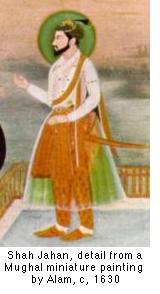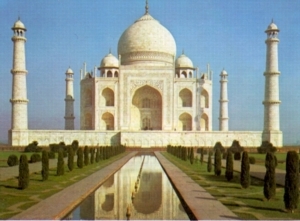Shah Jahan (Prince Khurram; Shahab-ud-din Muhammad Sahib Qiran Sani Shah Jahan)
Mughal emperor of India, b. 5 January 1592 (Lahore, India), d. 22 January 1666 (Agra).
 Khurram was the third son of the Mughal emperor Jahangir and the Rajput princess Manmati. His father was more interested in the arts than in politics and administration, and after the marriage between Khurram and the niece of his wife Nur Jahan in 1612 Khurram became part of the influential circle of Nur Jahan and her relatives, who were in control of the day-to-day affairs of the empire.
Khurram was the third son of the Mughal emperor Jahangir and the Rajput princess Manmati. His father was more interested in the arts than in politics and administration, and after the marriage between Khurram and the niece of his wife Nur Jahan in 1612 Khurram became part of the influential circle of Nur Jahan and her relatives, who were in control of the day-to-day affairs of the empire.
In 1622 Khurram felt that Nur Jahan planned to sideline him in the succession for the throne. He fell out with her and started a rebellion against Jahangir's reign. For several years he and his troops were chased around the states of the empire. In 1626 Khurram surrendered without conditions and was reconciled with his father. He was declared emperor in February 1628, four months after Jahangir's death, and took the name Shah Jahan.
As the new emperor Sha Jahan continued the history of territorial accessions of his father and grandfather (Akad the Great). He annexed Ahmadnagar and made other states of the Deccan (the southern Indian peninsula) tributaries to his empire. His confrontations with Persian forces in Afghanistan met with mixed success; control over Qandahar and other cities changed several times.
When Shah Jahan fell ill in 1657 his four sons embarked on a struggle of succession, from which Aurangzeb emerged as victor in 1658. Aurangzeb declared himself emperor and placed his father under house arrest in the fort of Agra. Shah Jahan lived the last decade of his life as prisoner of his son.
Shah Jahan's interest in cultural affairs focussed on architecture; some of the finest buildings of Islamic architecture were created under his reign. In his capital Agra he was responsible for the construction of the two mosques Moti Masjid and Jami' Masjid (Great Mosque) and the famous mausoleum Taj Mahal, considered by many the most beautiful building on earth. Having relocated the capital from Agra to Delhi he embarked on the construction of a huge fortress-palace known today as the Red Fort. He also built another Jami' Masjid in Delhi, one of the finest mosques of India.
The splendour of Shah Jahan's court and the cultural achievements of his reign often led Muslim and Indian writers to refer to him as the ideal Muslim ruler. Sha Jahan continued the tradition of religious tolerance of his father and grandfather but did not see its importance as much as they did. His military expeditions to gain or keep control of Qandahar nearly bankrupted the empire. The decline of the Mughal empire under Aurangzeb was certainly not Shah Jahan's making, but his reign already carried the seeds of decline in it.

The Taj Mahal in Agra, India.
home
 Khurram was the third son of the Mughal emperor Jahangir and the Rajput princess Manmati. His father was more interested in the arts than in politics and administration, and after the marriage between Khurram and the niece of his wife Nur Jahan in 1612 Khurram became part of the influential circle of Nur Jahan and her relatives, who were in control of the day-to-day affairs of the empire.
Khurram was the third son of the Mughal emperor Jahangir and the Rajput princess Manmati. His father was more interested in the arts than in politics and administration, and after the marriage between Khurram and the niece of his wife Nur Jahan in 1612 Khurram became part of the influential circle of Nur Jahan and her relatives, who were in control of the day-to-day affairs of the empire.